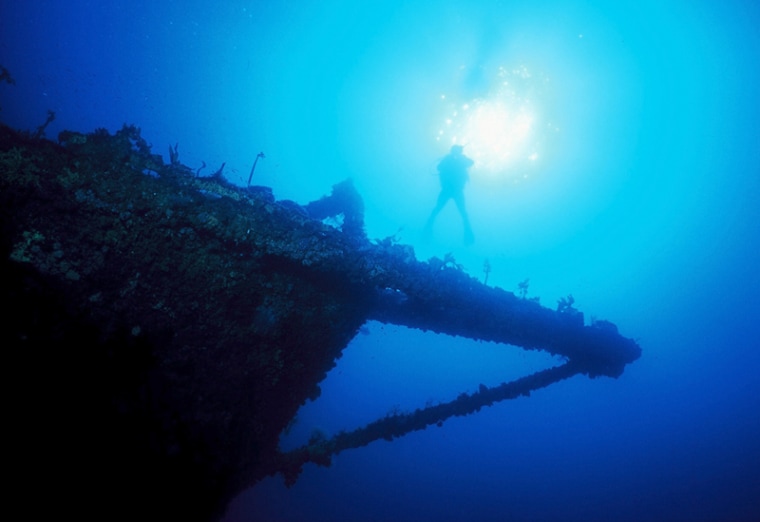It was almost a century ago, on a cold and starry April night in the north Atlantic, that the unthinkable occurred: A giant iceberg tore through the underbelly of the RMS Titanic, sending the “unsinkable” ship to a frosty grave, and claiming the lives of nearly 1,500 passengers onboard. For more than 70 years, the ship’s secrets lay on the ocean floor. Even after she was discovered in 1985, the Titanic remained elusive, submerged 12,000 feet beneath the sea.
Today, though, anyone with a bit of cash to burn can probe the world’s most famous wreck. Thanks to companies like the Australian-based Adrenalin, intrepid travelers can explore the Titanic’s remains aboard a MIR submarine. It’s a once-in-a-lifetime opportunity for underseas enthusiasts—so long as they’re not put off by the $40,000 price tag.
Fortunately, most of the world’s great shipwrecks aren’t buried two miles beneath the surface. Many can be reached with little more than a good dive boat and a tank of Nitrox, including the World War II graveyards of the Pacific and the haunting remains of Spanish galleons in the Caribbean. There are thousands of wrecks that are easily accessible to recreational divers. And for all the beauty of natural attractions like Belize’s Blue Hole or Australia’s Great Barrier Reef, it’s these eerie, evocative remains that hold a special allure for many divers.
“It’s the whole back story of the wreck that’s intriguing to so many people,” says Nick Lucey, editor-at-large of Scuba Diving Magazine. “The lives lost, the drama, the circumstances. It’s like a reef with a history, with a human element that’s totally unique.”
For Joe Porter, editor-in-chief of Wreck Diving Magazine, that history is often more appealing than the wreck itself. “My favorite dives are probably a little bit different,” he says, “in that I don’t really need an intact structure to see or go into.” He notes that artificial reefs, like the USS Oriskany, in the Gulf of Mexico, are often “great wrecks in that they’re intact, and they’re massive ships that you can really penetrate.” What’s missing, though, is a certain mystique.
“They don’t have the history that I go for,” he says.
From wartime tragedies to natural disasters to tales of international intrigue, the best shipwrecks are often less about the spectacle than the story behind it. And sometimes, they offer a few surprises.
On one of Porter’s most memorable dives, he was part of a group that combed through the sunken remains of the Santa Margarita and the Atocha. The two galleons were loaded with New World treasure when they were struck by a hurricane off the coast of Key West in 1622. They settled to the seabed below, where curious fish were their only company for the next 300 years.
Both ships have been devoured by time, and today “there’s not a whole lot to see,” Porter admits. But as his group was raking the sea floor, “we found gold, and a small box made of wood [that] contained more than 6,000 pearls.” It was a good find, but unfortunately for Porter and company, they were a few decades late: When the treasure hunter Mel Fisher dove the same site in 1985, he discovered thousands of silver coins worth more than $400 million.
But it’s not all about cashing in for divers drawn to the world’s watery graveyards. Names like the SS Thistlegorm and the USS Saratoga are spoken with reverence in the diving community, simply for the thrill of seeing their great, coral-crusted carcasses on the ocean floor. And while even the busiest globetrotters might not make it to Micronesia, wreck aficionados know that Truk Lagoon—the site of a heavy aerial bombardment during World War II—offers some of the best dives on the planet.
Author Jack Jackson has collaborated on dozens of dive books as a writer, editor and photographer. He returns to the Philippines regularly because there’s such variety off its shores, especially around Coron Island and Subic Bay. If forced to pick his favorite dive, though, the award-winning author looks to an unlikely place: off the coast of Sudan.

“The Umbria is really the most interesting [wreck],” he says of the famous freighter, which was sunk while transporting Italian bombs before the outbreak of World War II. Jackson calls it “the world’s most photogenic wreck,” and he returns to Sudan regularly, often to lead dive groups to the Umbria’s remains.
While most of the planet’s top wrecks are sunk in far-flung locales, many spectacular dives are lurking in our own backyards. The coast of North Carolina, in particular, is littered with wrecks from the World War II era; there, both German U-boats and the ships they preyed upon rest on the ocean floor. Up north, the frigid waters of the Great Lakes hold more than 4,000 catalogued wrecks; but if you prefer to follow the snowbirds and beach bums, Lucey says “the Florida Keys has a fantastic collection as well.”
If your sights are still set on that most celebrated wreck of all, there’s good news on the horizon: Soon you won’t have to break the bank to explore the Titanic. To coincide with the ship’s centennial, a new theme park is scheduled to open in Belfast in 2012. The park will include exhibition galleries, a sculpture garden and a full-scale model of the famous ship, where visitors can prowl the captain’s quarters and the opulent dining hall.
The best part for landlubbers? They won’t have to get their feet wet to dive right in.
